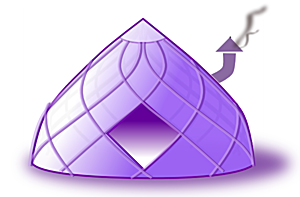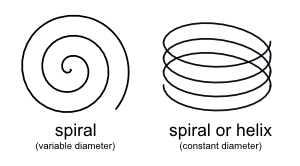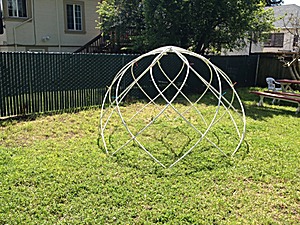UpdatesWed, May 30, 2012: Added photos of a PVC Zome
.
Tue, December 1, 2009: More description and illustrations, ready to be published
.
Tue, November 17, 2009: First version with a brief description and mathematical description, and real life applications.
.
|
also known as
Spinning Circles Zome, Feminin Helix Zome or simply
Feminin Zome.
The
Helix Zome is a variant of a zome composed by half helixes (helix = spiral with a constant diameter).
The term "Zome  " comes from "zonohedron
" comes from "zonohedron  " + "dome" combined - in strict mathematical terms the Helix Zome isn't a zonohedron anymore, yet, zome is often used for unusual dome variants, so I stick with the term as well.
" + "dome" combined - in strict mathematical terms the Helix Zome isn't a zonohedron anymore, yet, zome is often used for unusual dome variants, so I stick with the term as well.
The Helix Zome was developed by Nicolas Causse  back in 2006. I met Nicolas personally in summer 2009 and he introduced me to his concept of the Helix Zome.
back in 2006. I met Nicolas personally in summer 2009 and he introduced me to his concept of the Helix Zome.
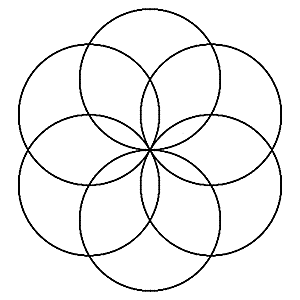
 Helix Zome (n = 6, top view) |
From a top view of the Helix Zome reveals circles crossing one central point, circles positioned around a circle, when choosing 6 circles (or helixes) following pattern appears (see left-hand side picture), also known as "Seed of Life", as part of the "Flower of Life".
The "Flower of Life  " is a metaphysical term, which relates to the origin of life itself, the circle, the first atom, the first entity or singularity, and its surrounding emanations - how circles can be arranged orderly around a central circle - an archetype of form itself.
" is a metaphysical term, which relates to the origin of life itself, the circle, the first atom, the first entity or singularity, and its surrounding emanations - how circles can be arranged orderly around a central circle - an archetype of form itself.
Nicolas insist of the term helix - and not spiral: the term spiral is often used to describe a circular form with an increasing or decreasing diameter, but also includes a constant diameter. At the first sight it may look like a spiral with an increasing or decreasing diameter, but it's a spiral of a constant diameter, for that reason Nicolas calls it a Helix Zome, a helix is a spiral with a constant diameter.
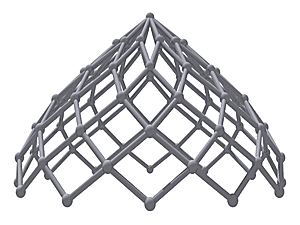
 Polyhedral Zome |

 Helix Zome |
The Helix Zome has its origin in its
polyhedral form, and Nicolas refined and smoothed it until he found the helix based form, he calls this variant the "feminine" zome, whereas the polyhedral the "masculin" zome.
The Helix Zome, from a polyhedral point of view, "represents a sort of combination of infinite frequency along with a finite subdivision", as Rob Bell  writes to me;
or "infinite frequency (n -> infinite) the polar zonohedron of order n approaches a solid of revolution created by rotation of a sine curve" (source: Chilton and Coxeter 1963, Towle 1996).
writes to me;
or "infinite frequency (n -> infinite) the polar zonohedron of order n approaches a solid of revolution created by rotation of a sine curve" (source: Chilton and Coxeter 1963, Towle 1996).
There are several ways to describe the helix zome, let's feature here two of them: Spinning Circles, and Parametric Approach.
| side view 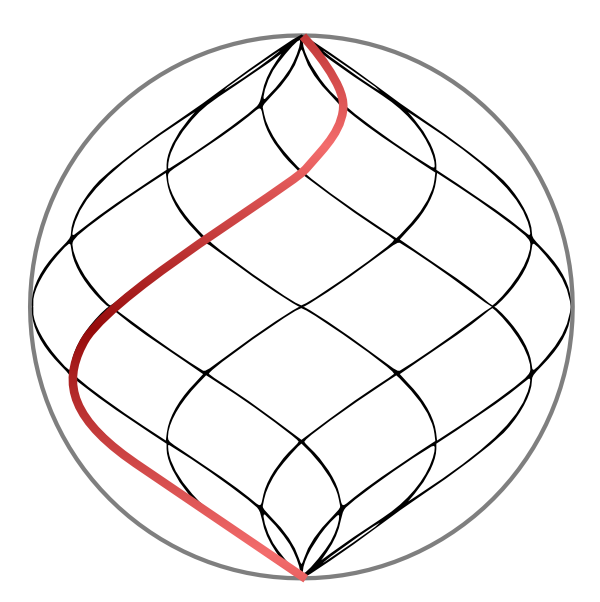
|
top view 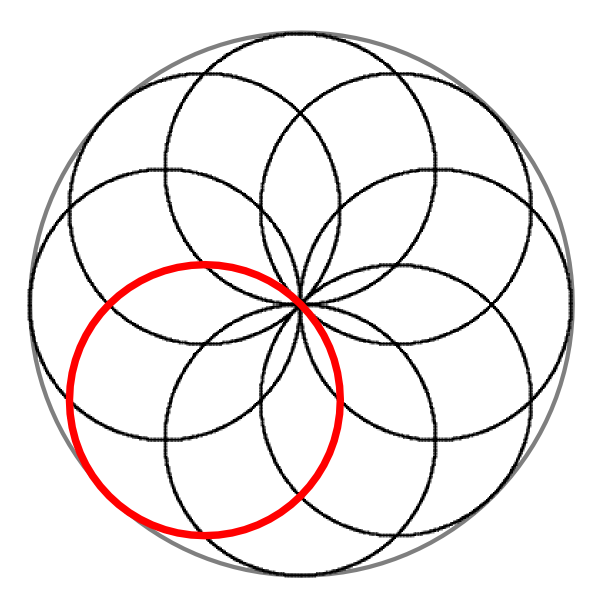
|
Since we cut the form into a helix dome or zome, only half of the spinning is done.
A helix zome is composed by n-amounts of double helix, the coordinate of one partial helix:
x = sin(α + β) d/4 + sin(β) d/4
y = cos(α + β) d/4 + cos(β) d/4
z = (α / π) d/2 vs or α / π h
whereas
- α = 0..π,
- β = (2π / n) i
- n = amount of double helixes,
- i = 0..n-1 and
- d = diameter of the helix zome
- vs = 1.0 .. 2.0 stretch vertically
- h = height
The length of a rib is:
lrib = √ ( d2 π2 / 16 + h2 )
considering l
rib = √ ((d
rib π / 2)
2 + h
2) whereas d
rib = d / 2
For better usage, the helix zome can be vertically stretched, 125% to 150% are suitable for a dome application:
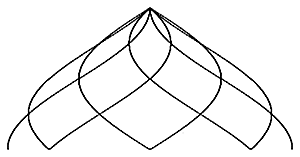
100%
2009/11/30 13:01
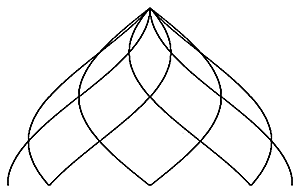
125%
2009/11/30 13:01
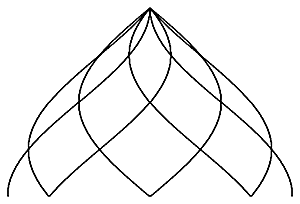
133%
2009/11/30 13:01
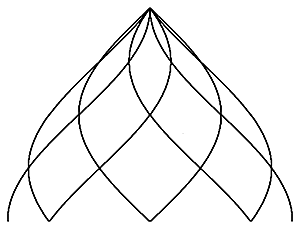
150%
2009/11/30 13:01
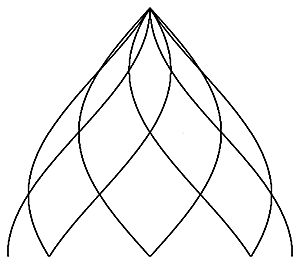
175%
2009/11/30 13:01
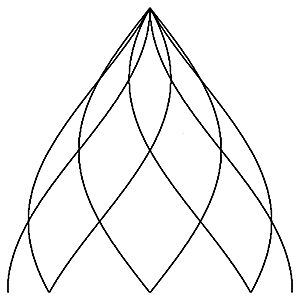
200%
2009/11/30 13:01
All examples have h = 133%
| side view 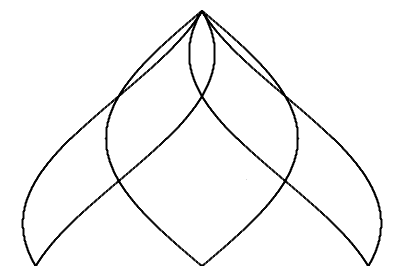
n = 6
| top view 
n = 6
|
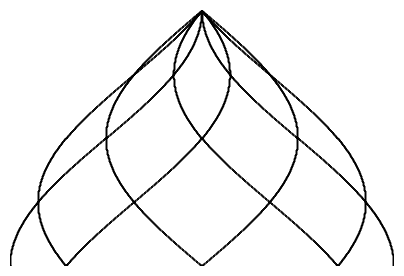
n = 8 | 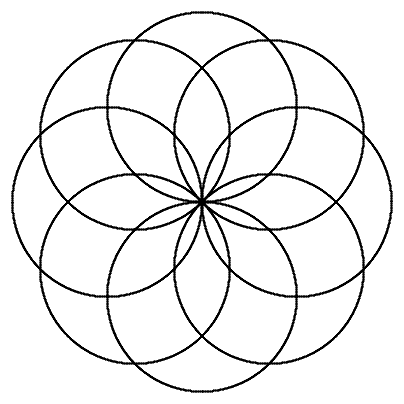
n = 8 |
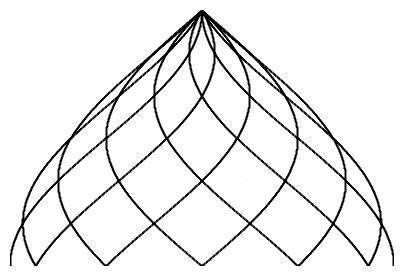
n = 12 | 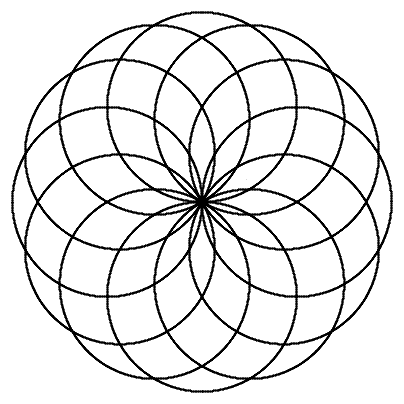
n = 12 |
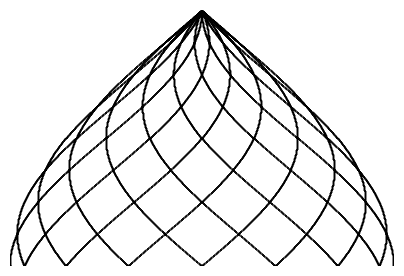
n = 16 | 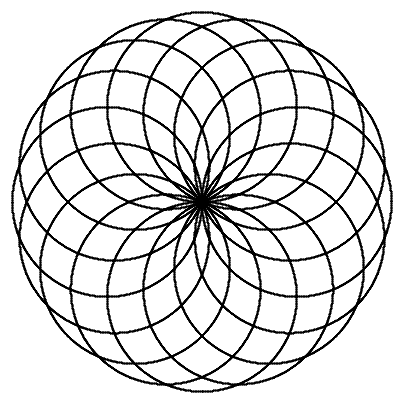
n = 16 |
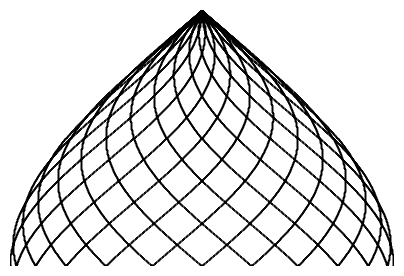
n = 24 | 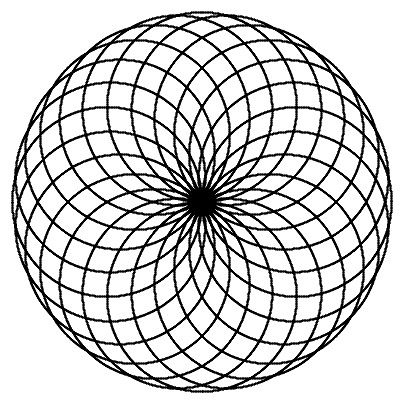
n = 24 |
Nicolas Causse  made a few helix zomes with wood and with interior covers:
made a few helix zomes with wood and with interior covers:
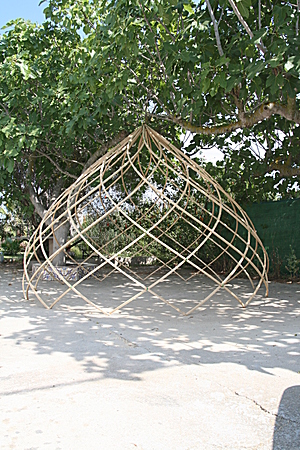
2009/12/01 13:30
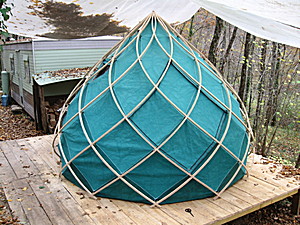
2009/12/01 13:30
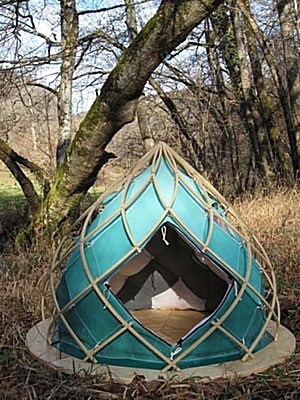
2009/12/01 13:49
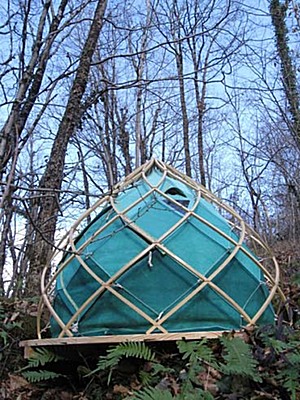
2009/12/01 13:49
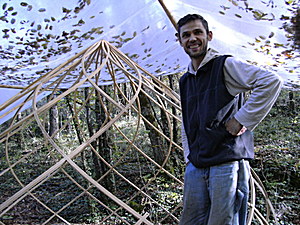
2009/12/01 13:31
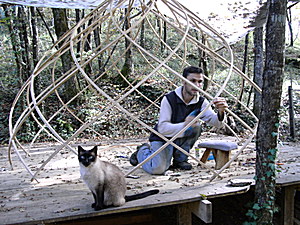
2009/12/01 13:31
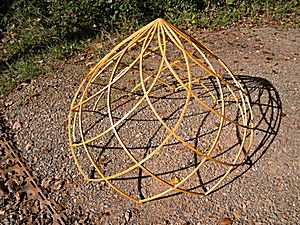
2009/12/01 13:31
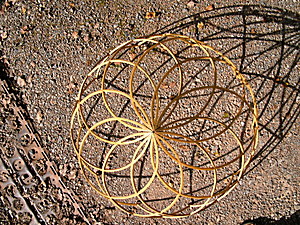
2009/12/01 13:32
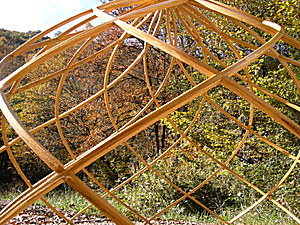
2009/12/01 13:32
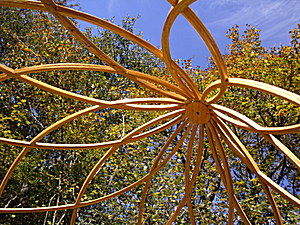
2009/12/01 13:32
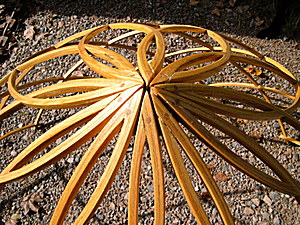
2009/12/01 13:33
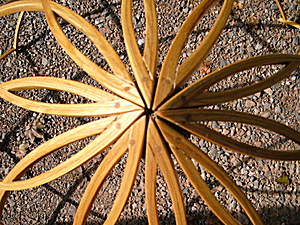
2009/12/01 13:33
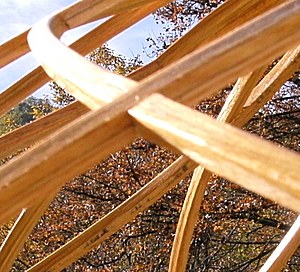
 Rib Crossing/Junction Close Up |
The Helix Zome looks very complex but actually is just composed by helixes but those aren't trivially to be fabricated when you choose a square profile as Nicolas fabricates his helix zomes.
He works about 120 hours on a wooden 3m Helix Zome with 10 helixes, with a sophisticated tool to bend 4 smaller ribs into a larger rib.
The reason for this overhead is, that the square profile rib is not only spiraled in a constant diameter, but has a slight twist around itself as well so the intersection can be interlocked and the surface remains seamless.
I may do some tests with circular profile ribs, either a bent bamboo or a metal torus cut apart.
Also, the Helix Zome isn't particular strong in its geometry (top down weakness), and therefore doesn't really suit a larger application unless you triangulate the structure properly.
On the other hand it's one of the most beautiful dome applications I came across.
Dustin Hoffman 
used PVC pipes, a simple implementation method:
He shared also some of his experiences:
What I really learned through the process though was that using 4-way connectors like these  was the way to go. Because the more connections you can make at the top within the same vertical space, the better the structure looks. I initially used 8 of these 45 degree connectors
was the way to go. Because the more connections you can make at the top within the same vertical space, the better the structure looks. I initially used 8 of these 45 degree connectors  which made the top of the zome look all tangled. I wish I could find a 16-way pvc connector, that would be wonderful.
which made the top of the zome look all tangled. I wish I could find a 16-way pvc connector, that would be wonderful.
The first two photos are from a version woven 3 times. Each pipe crossing 3 other pipes before meeting at the vertex. The other photos are from another take only woven 2 times. Overall this version is much much easier to weave, and provides more headspace because there is less lateral weaving, and each pipe's length is converted into vertical space instead.
There is much less tension in the one woven twice, so I was able to make a door with two of the pipes. The pipes are all stuck on rebar stakes which I plant using a rope to ensure they adhere to a perfect circle.
.:.

 used PVC pipes, a simple implementation method:
used PVC pipes, a simple implementation method:







